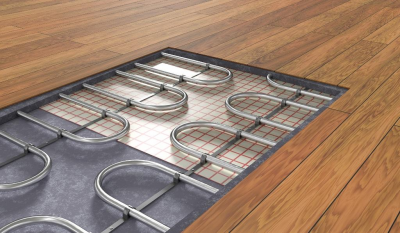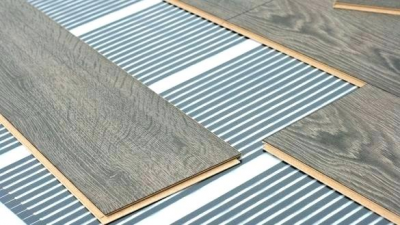
RADIANT FLOOR HEATING
You may, or may not, be familiar with radiant floor heating, but if you own a house in a colder climate, then it is something that you really should consider. The technology for radiant floor heating has been around for a long time, and breakthroughs in technology and techniques are still regularly occurring. Let me walk you through the different types of radiant floor heating and their pros and cons.
There are three major types of radiant floor heating: hydronic, electric, and air-heated. They all work on the same principle, which is concealing a heat source under your flooring, so that you can more efficiently heat your floor, room, or the entire home.
HYDRONIC RADIANT HEATING
Hydronic radiant heating is the oldest and first to be widely used. You can find it in all sorts of buildings to this day. Hydronic radiant heating gets its name from its use of circulating hot water through pipes in a building or house in order to cheaply and efficiently distribute heat. Due to the nature of the tubing, this type of radiant heating usually needs to be installed during construction and isn’t really an option if you are simply looking at a remodel.
Furthermore, hydronic radiant heating is the most efficient of the three radiant heating techniques, allowing you to cheaply heat the water using electricity, solar, gas, old school boilers, oil or even geothermal. However, the downside is that hydronic radiant heating has the highest maintenance cost - flooring and walls must be removed to service any leaky pipes. This has gotten better in recent times, as the pipes used are much higher quality than they used to be, resulting in a stronger and more leak-resistant system that is less prone to becoming brittle with age.
Strongly consider hydronic radiant heating if you are in the early stages of home construction or planning, and especially if you plan to use an alternative power source such as solar.
Click Here To Shop floors perfect for Hydronic Radiant Heating
ELECTRIC RADIANT HEATING
Electric radiant heating is the most common type to be found in modern homes and can be installed after construction. It works by using rolled cables attached to mats, film, or mesh constructed of resilient, heat-conductive materials. The mats can then be installed directly into the concrete slab during construction, or installed after construction underneath the subfloor. They can even be placed directly under the flooring, depending on the type of flooring used.
This method works by using independent zone thermostats that can control each room’s floor, meaning that you can heat up just one floor, a single room, or even the entire house. No more climbing out of bed onto an icy floor in the mornings. Electric radiant heating works so well that it is even installed under driveways, sidewalks, and roads as an alternative and efficient way to de-ice without using salts or chemicals.
This is a perfect choice if your house is already built or you don’t want to have to worry about any maintenance down the road.
Click Here To Shop floors perfect for Electric Radiant Heating
AIR-HEATED
Finally, we come to hot air heating, or simply air-heated. This is the least popular type of radiant floor heating as it’s not very efficient. The way it works is that air is heated and then pumped through a system of pipes embedded in the floors. Air is a poor conductor of heat so it usually only serves to heat the floors, but not the rest of the room or house.
We don’t recommend this route as it has to be installed before construction is finished, like the hydronic systems, and you still have to pair it with another heating source. You really are better off going with one of the other two options.
Click Here To Shop floors perfect for Air-Heated Radiant Heating
CONCLUSION
There you have the three types of radiant floor heating to choose from, but a lot still goes into making a decision. Your house’s location, layout, foundation and flooring all make up a large factor about which (if any) to go with and you should talk it over with your contractor or flooring representative to find out what works the best for you.
As far as flooring goes, an engineered hardwood flooring is your best bet. Radiant heating systems also perform well with stone, ceramic, and porcelain tile floor coverings. Carpet and laminate flooring is not recommended as they can limit the heating capacity of radiant heating systems. As always, consult a professional before undergoing a large decision.
I hope this has been helpful - Let us know if you have any questions, and hopefully, by next winter, your home will be that much more comfortable and cozy!





What is pricing per square foot for new residential construction?